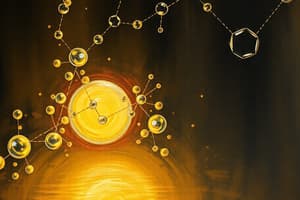Podcast
Questions and Answers
Which of the following accurately describes an isotope?
Which of the following accurately describes an isotope?
- Atoms with different numbers of protons and electrons.
- Atoms of the same element with different atomic masses. (correct)
- Atoms with unequal numbers of neutrons and electrons.
- Atoms that cannot exist in nature.
What is the defining characteristic of an ionic bond?
What is the defining characteristic of an ionic bond?
- It occurs between atoms of the same type.
- It involves the attraction between ions of opposite charges. (correct)
- It involves the sharing of electrons between nonmetals.
- It is formed solely between metals.
Which of the following is a characteristic of a molecule?
Which of the following is a characteristic of a molecule?
- It has the same properties as its constituent atoms.
- It can consist of just one type of atom.
- It must contain more than two atoms.
- It consists of atoms that are chemically bonded. (correct)
Which statement correctly defines a compound?
Which statement correctly defines a compound?
What does an electron dot formula represent?
What does an electron dot formula represent?
What is characteristic of a double bond between two atoms?
What is characteristic of a double bond between two atoms?
Which statement accurately describes a molecular formula?
Which statement accurately describes a molecular formula?
What occurs during the reduction process in ionic compounds?
What occurs during the reduction process in ionic compounds?
Which of the following correctly defines isomers?
Which of the following correctly defines isomers?
What distinguishes organic compounds from inorganic compounds?
What distinguishes organic compounds from inorganic compounds?
Flashcards are hidden until you start studying
Study Notes
Chemical Bonds
- Double Bond: Atoms share two pairs of electrons; example: ethylene (C2H4).
- Triple Bond: Atoms share three pairs of electrons; example: nitrogen (N2).
Chemical Formulas
- Structural Formula: Illustrates atomic arrangement and shared electrons; example: hydrogen sulfide (H2S).
- Molecular Formula: Indicates quantity of atoms in a molecule; example: two moles of carbon dioxide (2 CO2).
Oxidation and Reduction
- Oxidation (Ionic): Involves loss of electrons; example: sodium ion formation (Na → Na+ + e).
- Reduction (Ionic): Involves gain of electrons; example: fluoride ion formation (F + e- → F).
- Oxidation (Covalent): Involves loss of hydrogen atoms; results in an increase in oxidation state.
- Reduction (Covalent): Involves gain of hydrogen atoms; leads to a decrease in oxidation state.
Isomers
- Defined as molecules with identical formulas but distinct structural arrangements or spatial orientations; example: glucose (C6H12O6).
Types of Compounds
- Organic Compounds: Chemical substances that contain carbon; example: heptane (C7H16).
- Inorganic Compounds: Compounds not based on carbon, except CO and CO2; example: potassium chloride (KCl).
Atomic Structure
- Atom: Smallest unit of matter, indivisible by chemical means; example: helium atom consisting of 2 electrons (e), 2 protons (p), and 2 neutrons (n).
- Element: Pure substance comprising one type of atom; example: gold (Au).
- Isotope: Atoms with the same number of protons and electrons but differing in neutrons, leading to varying atomic mass; examples: Carbon-12 (6 e, 6 p, 6 n) and Carbon-13 (6 e, 6 p, 7 n).
Ions
- Ion: Atom or group of atoms with a charge, either positive or negative; example: sodium ion (Na+; 11 p, 12 n, 10 e).
Bonds
- Ionic Bond: Attraction between oppositely charged ions, typically between metals and non-metals.
- Covalent Bond: Attraction resulting from the sharing of electrons between nonmetal atoms; example: water (H2O).
Molecules and Compounds
- Molecule: Smallest unit where atoms are chemically bonded; retains properties of the compound; example: diatomic hydrogen (H2).
- Compound: Substances made up of more than one type of atom joined together; example: hydrogen fluoride (HF).
Electron Dot Formula
- Visualization technique representing valence electrons; dots indicate electrons in outer shells; example: neon (Ne).
Studying That Suits You
Use AI to generate personalized quizzes and flashcards to suit your learning preferences.



